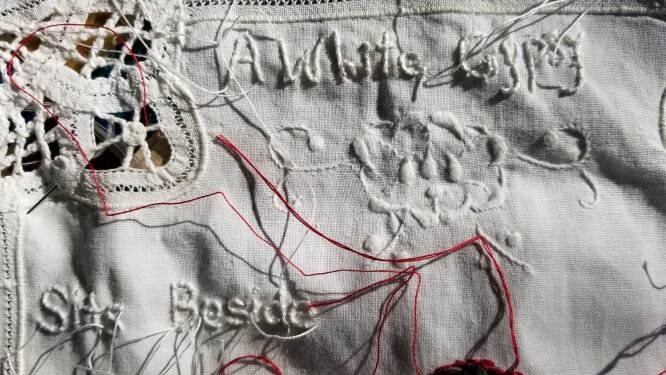INNOCENT #1 This installation of seven suspended sculptures conceptualizes the impact of climate change on women and children forced to flee from homelands impacted by drought and flood.
Reclaimed vintage baby dress sourced from Who Gives A Scrap, encaustic, hand waxed threads, hand stitched embroidery, wire,18 x14 x 13 (+22” descending threads). Available December 2021 from Kreuser Gallery.
An apropos quote I discovered while reviewing my personal 1991 journal written by Ralph Ellison, pg 85, “The Second Black Renaissance:”
“Flight is an inherently ambiguous term, connecting freedom and desertion alike.”
People Move. They move for many reasons. They always have.
In the USA, we're lucky. We have big space, big options, to move for any reason...jobs, family, personal preferences regarding city vs. country, ocean vs desert vs mountains vs prairies.
In the last two years, how many people do you know who have moved? I have friends who have moved from Alaska to here (Colorado Springs), from here to Phoenix, from here to Washington state, from NYC to here.
In other parts of the world, people must cross borders to move the distances we Americans take for granted as possibilities. Ken Burn's film “The Dust Bowl” documents the man-made ecological disaster that precipitated the mass migrations of the 1930's. For instance, Colorado farmers from the San Luis Valley moved north to the mountains become miners. And for generations in America, families have moved “up,” seeking safer neighborhoods to raise their children.
In most of the world, people are born into families that reside in small geographic countries in which climate change has impacted their ability to raise the traditional crops that sustained their ancestors. As Mother Nature demonstrates that climate change is here to stay, the impacts on a population's ability to survive a location with flooding or famine will continue to create climate refugees.
Bottom line: People don't just naturally want to pick up and abandon the place they've lived for generations without good reason. The artificial borders we define as countries are barriers that kill.
Women and children, the innocents, are fleeing countries not because they want to live in another country, but because they must, for survival. It's a problem without an answer.
Solutions can only begin once we understand that these climate refugees are acting out of desperation rather than criminality.
Raising awareness of the global refugee crisis through Art. The full installation provided a visual way to process the enormity of 25 million – the approximate number of refugees estimated by the United Nations High Commissioner for Refugees when this project commenced.My contribution to the international collaborative art project, “25 Million Stitches.”











